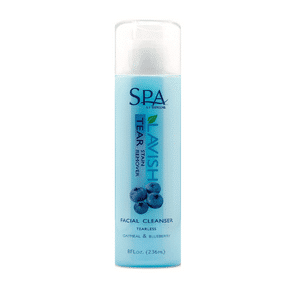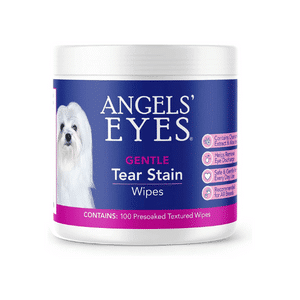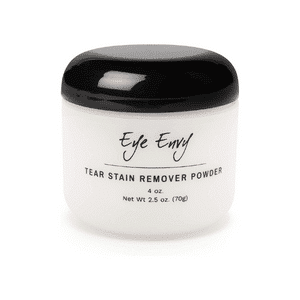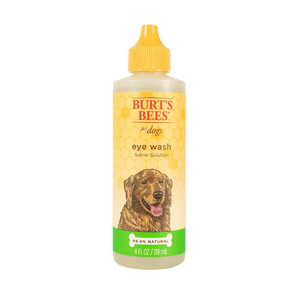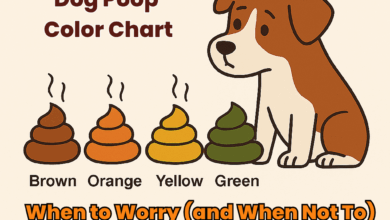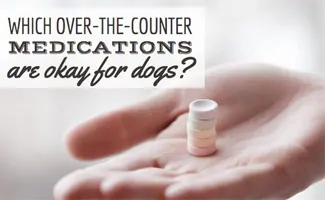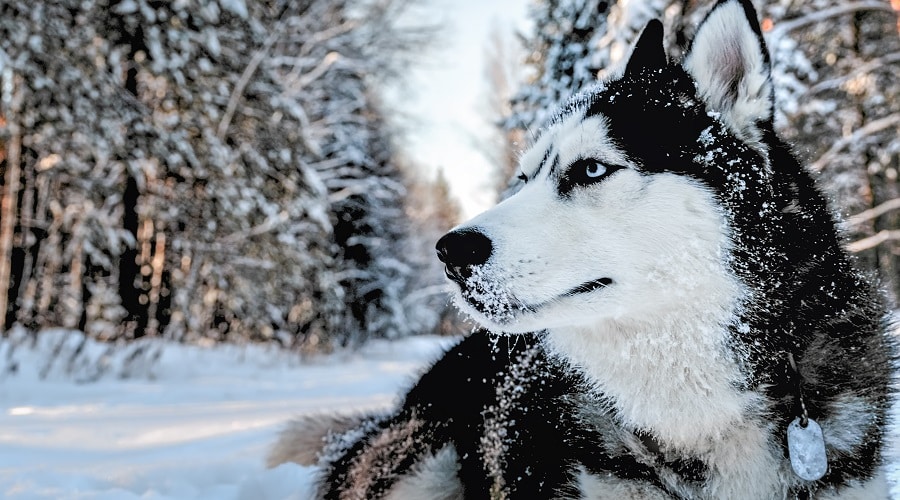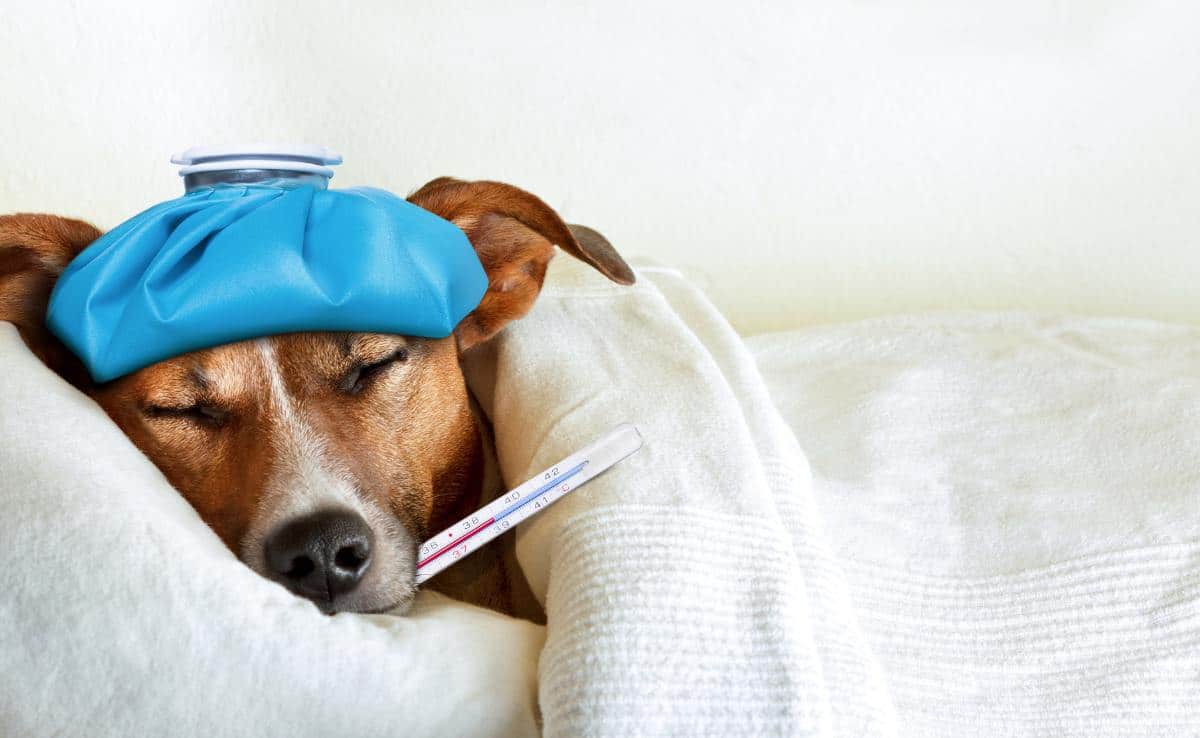The Real Reasons Your Dog Has Reddish Tear Stains & How To Fix It Fast
When you purchase through links on our site, we may earn a commission. Here’s how it works.
Those rusty-looking streaks under your dog’s eyes? They’re not just from tears, and no, wiping won’t fix them for long.
Table of Contents
These stubborn stains might be your dog’s way of signaling something deeper, from clogged tear ducts to sneaky food sensitivities. So, here’s what’s really behind them and the fastest ways to clear them up for good.
What Causes Dog Tear Stains?
Wondering, “Why does my dog have tear stains?” Many people assume tear stains come from too many tears, but that’s only part of the story.
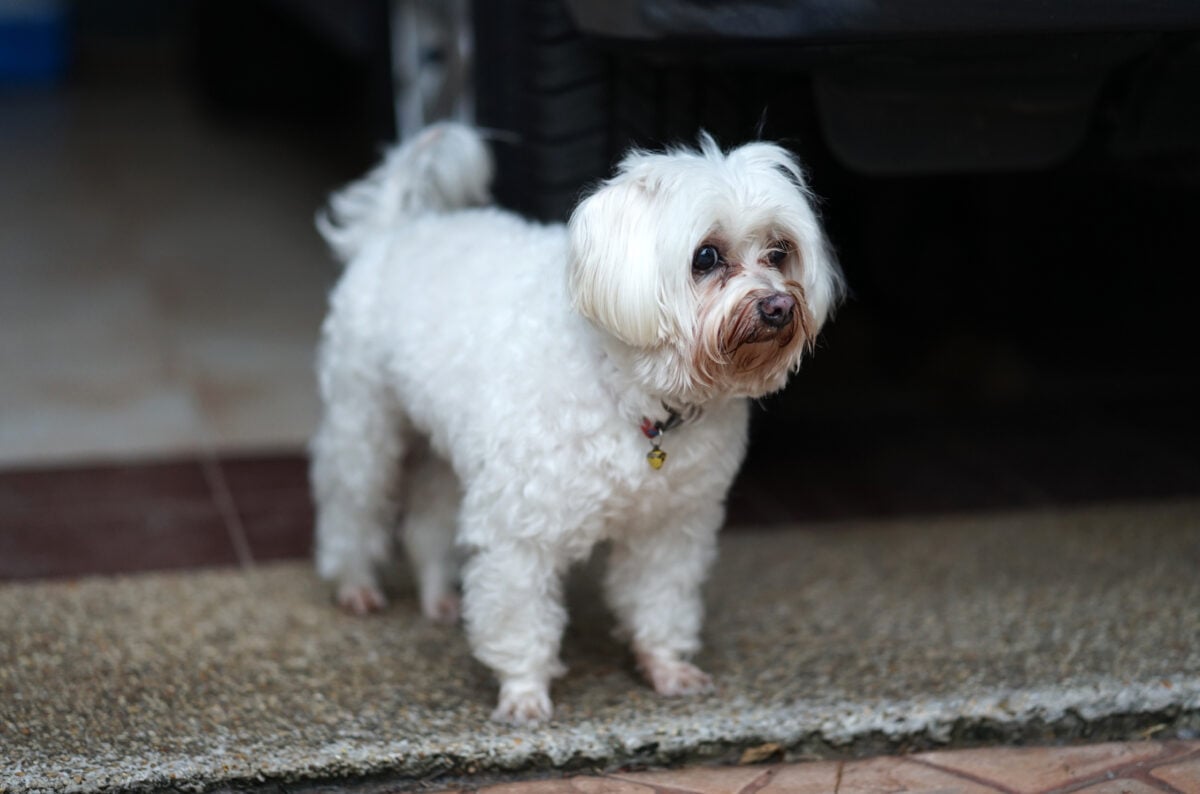
According to experts at MedVet, the real culprit behind those rusty streaks is porphyrin, a natural molecule in your dog’s body. When these porphyrins are exposed to air, they oxidize… and boom: reddish stains appear, especially on light-colored fur.
So, wiping away the stains is just the start, but keeping them gone takes some daily effort. From wipes to washes to food tweaks, there’s no one-size-fits-all fix. Some dogs respond quickly to gentle cleaning, while others need a full-on routine (plus a little trial and error).
The good news? There are effective options. The key is finding what works for your dog and avoiding anything harsh or gimmicky.
3 Signs Of Tear Stains
Tear stains aren’t always just red streaks, and they’re not always easy to see. On light-colored dogs, they show up as rusty or reddish discoloration beneath the eyes. Tear stains are much easier to spot on light-colored dogs.
But if your pup has dark fur, the only sign might be constantly damp, matted hair below the eyes. Whatever color your dog’s fur is, here are the main symptoms of dog tear stains:
- Reddish stains on white or light fur
- Wet or gunky fur under the eyes
- Sticky discharge (but not always present)
Constant wetness creates the perfect conditions for yeast and bacteria to grow, leading to skin infections and discomfort for your dog.
If your dog’s stains are brown instead of red, they could have a yeast infection, which often can have a foul odor. If your dog’s tear stains are brown, you should see your veterinarian for treatment to clear up the potential infection. More on that later.
3 Best Dog Tear Stain Removers
Let’s start with some of the best products out there for tackling tear stains. Just a heads-up – if your dog has heavy staining, it might take a little time (and consistency) to see real results.
1. TropiClean SPA Tear Stain Remover For Pets Review
SPA Tear Stain Remover gets excellent reviews from pet parents and groomers. This USA-made solution contains coconut cleanser, vitamin E, oatmeal, white tea, and other all-natural ingredients.
Simply put a few drops on your finger or a cotton ball, gently scrub it onto your dog’s stains, leave it on for about three minutes, and rinse. It also has a pleasant vanilla and blueberry scent.
Price
- Starts from $12.99
2. Angel’s Eyes Gentle Tear Stain Wipes Review
Angel’s Eyes wipes are a popular choice for many owners because they’re so easy to use. The wipes are pre-soaked and textured and require no rinsing after you use them.
They’re also helpful in removing dried mucus and secretions. This solution is gentle on the fur and skin and contains no bleach, antibiotics, or harsh chemicals. They’re also made in the USA.
Price
- $15.29 ;
3. Eye Envy Tear Stain Remover Powder Review
Many pet parents swear by this product. It’s an all-natural powder that you can apply to your dog’s tear stains after cleaning them (many say using a toothbrush to apply the powder works best).
Although the powder is part of Eye Envy’s three-step tear stain removal kit, many people choose to only use the powder. It contains herbs such as goldenseal, echinacea, and eyebright, and boric crystals to cleanse and keep hair dry.
Also made in the USA, it’s cruelty-free and contains no parabens, peroxide, bleach, steroids, antibiotics, or other harmful agents.
Price
- Starts from $13.99
4 Home Remedies to Clean Tear Stains
Searching for a natural way to clean your dog’s tear stains? The internet is full of DIY tricks, but not all of them are safe or effective. Some can irritate your dog’s eyes or skin if used incorrectly.
Below are a few home remedies that many pet parents use with success, but always check with your vet before trying anything new, especially near your dog’s eyes.
Important: Never apply any solution into your dog’s eyes. These remedies are only for external use on the fur.
1. Diluted Hydrogen Peroxide (Use With Caution)
According to the American Kennel Club (AKC), the primary home remedy for tear staining on dogs is to mix a tablespoon of mild hydrogen peroxide into an eight-ounce glass of water.
Use a cotton pad to gently dab the stained area, being extremely careful to avoid the eyes. This can help lighten stains, but it may irritate sensitive skin, so test a small area first and don’t use it daily.
2. Contact Lens Solution (Boric Acid)
According to many online veterinary resources, such as Oakland Veterinary Referral Services (OVRS), some contact lens solutions contain boric acid, which may help gently oxidize and lighten stains.
Choose a preservative-free version and use it like a wipe, not a rinse. Only apply to fur, not the eye itself.
3. Boric Acid and Distilled Water
If you don’t have any contact lens solution at home, OVRS suggests boiling 1 tablespoon of boric acid powder in 1 cup of distilled water, then letting it cool.
Store in the fridge and apply with a soft cloth or cotton pad once cooled. This mixture can help reduce discoloration by neutralizing the iron in porphyrins. Again, do not get it in the eyes.
4. Cornstarch
Lightly dab cornstarch over the stain to absorb moisture with a clean cloth.
This is a gentle, dry method that can help reduce the wetness that leads to tear staining. It won’t remove existing stains but may prevent them from worsening.
7 Easy Daily Habits to Prevent Tear Stains
Once you’ve cleaned up the stains, the next step is keeping them from coming back. These simple daily routines can help prevent future staining, and most take less than two minutes a day.
1. Wipe Your Dog’s Eyes Every Day
Tear stains start when moisture lingers under the eyes and mixes with bacteria or fur pigments. Use a damp cloth, saline pad, or tear stain wipe to gently clean under the eyes every day, especially for dogs with light-colored coats. Catching the buildup before it sticks is key.

2. Trim the Hair Around the Eyes & Nose
Long or unruly hair near the eyes can irritate the eye surface, triggering excess tearing. That constant moisture is a major cause of staining. Keep this area neatly trimmed, either at home with grooming scissors or by asking your groomer to pay special attention to the face.
3. Clean Food & Water Bowls Daily
Bacteria and yeast love dirty bowls, and they can make tear staining worse. Use stainless steel or ceramic bowls (never plastic, which can harbor microbes), and wash them with hot, soapy water every day. It’s a small step that makes a big difference.
4. Use Filtered or Bottled Water
Minerals like iron and magnesium in tap water can contribute to reddish stains on your dog’s face. Switching to filtered or bottled water may help reduce staining over time, especially for dogs that are extra sensitive to trace minerals in municipal water sources.
5. Do a 10-Second Eye Check
Get in the habit of giving your dog’s eyes a quick once-over every day. Look for signs of irritation, crusty buildup, or unusually heavy tearing. Catching small problems early, like a blocked duct or minor allergy, can prevent bigger (and messier) issues later.
6. Try a Saline Eye Rinse
Flushing your dog’s eyes with a dog-safe saline rinse (like Burt’s Bees Eye Wash) can help wash away irritants, allergens, and debris that lead to tear overproduction. Always follow the instructions and use only vet-approved solutions.
7. Gently Clean and Dry the Face Daily
Use a warm washcloth and mild, tear-free cleanser, such as baby shampoo or a dog-safe face wash, to gently clean your dog’s face, especially around the eyes. Make sure to fully dry the area afterward. Damp fur creates the perfect environment for stain-causing bacteria to grow.
A Healthier Diet Can Make A Big Difference
You can scrub and wipe all day, but if your dog’s diet is part of the problem, the stains will just keep coming back. Some dogs develop tear stains because their food causes low-grade inflammation or allergic reactions, which can trigger constant eye watering.
How Diet May Affect Tear Stains
- Low-quality ingredients → Can lead to inflammation and excess tearing
- Food sensitivities → Trigger watery eyes and skin irritation
- Artificial additives → Some preservatives and dyes may worsen symptoms in sensitive dogs
- Too much sugar or yeast → Can feed the bacteria and yeast that make tear stains darker and smellier
- High-iron proteins like beef → May increase porphyrin production, which causes reddish stains
3 Diets To Try Instead
In addition to removing red meat from your dog’s diet, switching to high-quality dog food that’s low in carbohydrate fillers has been shown to help with tear staining. Such ingredients as wheat, corn, meals, by-products, and artificial preservatives can cause inflammation in the eyes, particularly if your pup has allergies.
- Limited-ingredient or hypoallergenic diets – Fewer triggers, cleaner response
- Grain-free diet (if recommended by your vet) – Sometimes helps, but not a magic fix
- All-natural dog food – The fewer fillers, the better
Remember to introduce new diets gradually, and always ease your dog into a new food over 7–10 days. While food won’t solve every case, switching diets made a visible difference for some dogs within weeks.
Dietary Supplements May Help
Some pet parents find that adding a teaspoon of organic apple cider vinegar to your dog’s water or food every day can help minimize tear stains.
Others have found success with the use of daily supplements formulated to help with tear staining. I recommend all-natural USA-made products, such as NaturVet Tear Stain Supplement.
Just keep in mind that it can take up to two months of daily use to see results with most dog tear stain products.
2 Final Options Vets May Recommend
Have you tried everything, but those stains still won’t budge? It might be time to explore some next-level options, but proceed with caution. Not every fix is meant for long-term use.
1. Antibiotics
Antibiotics such as tylosin or tetracycline can be effective in reducing tear staining in some dogs, but there’s controversy about their use for purely cosmetic reasons.
Why? As with humans, there’s concern about dogs building up a resistance to antibiotics, according to the Innovative Veterinary Journal and other experts. And long-term antibiotic use isn’t recommended by veterinarians.
2. Vet Procedures
If your dog has blocked tear ducts, inward-growing lashes, or chronic eye infections, your vet may recommend minor procedures to correct the issue. These are often low-risk and can dramatically reduce or eliminate tearing altogether.
When Tear Staining On Dogs Means Something More
If your dog’s eyes are constantly watery, irritated, or producing thick discharge, it might point to an underlying health issue, such as:
- Glaucoma
- Conjunctivitis
- Eye problems
- Eye infections
- Ear infections
- Ingrown eyelashes
- Allergies
You should also be concerned if the stains suddenly appear out of nowhere, smell funky, or seem to spread. These signs could mean bacterial or yeast overgrowth, especially in breeds with facial folds.
When To Call Your Vet
- Yellow or green goop in the eyes
- Brown stains rather than red
- Swelling, redness, or rubbing of the face
- Foul-smelling or rapidly spreading stains
- New or worsening stains in older dogs
How Vets Diagnose The Root Cause
If tear stains keep coming back no matter what you try, it might be time to let the pros take a look.
Vets don’t just glance at the stains. They dig into what’s really causing the over-tearing. They’ll look at:
- Tear duct function – Is the eye draining properly, or is fluid building up?
- Eyelid anatomy – Shallow eye sockets or hairy eyelids can trap moisture
- Stain swab – To check for yeast, bacteria, or other irritants
- Allergy screening – Environmental or food-based allergens can trigger excess tearing

Vets don’t treat the stain; they treat the source. Once that’s under control, the stains usually clear up on their own.
How Normal Tear Drainage Works
To understand your dog’s eyes a little more, let’s explore how tear drainage works, which might help you understand why some breeds are more at risk.
Your dog’s eyes naturally produce tears to keep them moist and clean. But those tears are supposed to drain through small ducts in the inner corner of the eyes.
Here’s the basic flow:
- The lacrimal (tear) glands produce tears.
- They wash across the eye’s surface.
- They drain into the puncta, which are tiny holes near the inner corners of the eyes.
- From there, they travel through the nasolacrimal duct into the nasal cavity.
But when that system breaks down due to blockages, underdeveloped ducts, or simply overproduction, the tears overflow and soak into the fur instead, causing those familiar red-brown streaks.
What’s In Dog Tear Stains?
Here’s the truth – those reddish streaks are not just dried tears.
Tear staining on dogs is caused by porphyrin, which is naturally found in your dog’s saliva, urine, and tears, is the culprit. Porphyrins are waste products produced when the body breaks down iron.
Add in constant moisture, skin folds, and maybe even a bit of bacteria, yeast, or dirt, and you’ve got the perfect storm for persistent tear stains.
While all dogs have porphyrin in their tears, some dogs have more than others. Porphyrin staining can be a normal cosmetic issue for many dogs rather than a health concern.
Tear Stains vs. Saliva Stains: What’s The Difference?
Both are often reddish-brown because of porphyrins, natural compounds found in your dog’s tears and saliva. Although tear stains and saliva stains can look nearly identical, they often come from completely different causes.
Before you reach for the wipes, make sure you know which type of staining you’re actually dealing with.
| Tear Stains | Saliva Stains | |
|---|---|---|
| Where They Appear | Under the eyes | Around the mouth, on paws, chest, or front legs |
| Main Cause | Excess tearing + poor drainage of porphyrins | Constant licking or drooling — especially from allergies or dental issues |
| Typical Color | Reddish or rust-colored streaks | Reddish-brown patches or matting |
| Common Breeds | Brachycephalic breeds, long-haired breeds | Dogs with allergies, skin irritation, or oral discomfort |
| What It Might Signal | Eye irritation, blocked tear ducts, abnormal facial anatomy | Allergies, boredom, dental problems, or anxiety-related licking |
If the stains are under the eyes, it’s likely tearing. If they’re around the paws or mouth, saliva is the likely culprit. Fixing it means treating the root cause, not just wiping it away.
Breeds Most Prone To Tear Stains
If it feels like your dog was born to have tear stains… you might be right.
Some breeds are just more prone to this than others, thanks to genetics, shallow eye sockets, and fluffy facial fur that traps moisture. The usual suspects? The cutest dogs with light fur, such as:
- Maltese – practically tear-stained mascots
- Shih Tzus – fluffy faces, wet eyes, constant cleanup
- Poodles & Doodles – tight curls trap moisture and darken stains
- Bichon Frise – light fur + watery eyes = streak city
- Bulldogs & Pekingese – facial folds make drainage tricky
- Cocker Spaniels – known for chronic eye issues
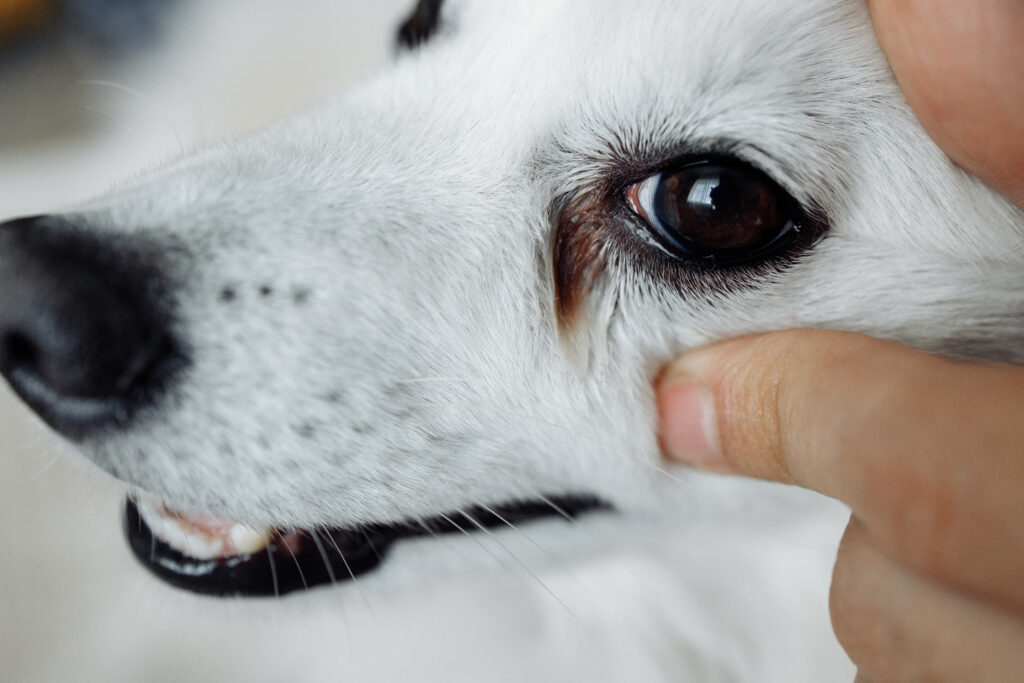
Some dog owners describe their pups as having “permanent eyeliner… applied by a toddler.” I feel you.
Why Some Dogs Stain More
Some dogs are just born leaky. It’s not their fault. It’s in their DNA. Certain breeds have eye structures that make tear stains almost inevitable. Think oversized tear glands, tiny tear ducts, or ducts that are blocked from birth.
There is also a congenital condition called imperforate punctum that results in underdeveloped tear ducts in some breeds, including Cocker Spaniels, Poodles, Golden Retrievers, and Labradors.
And if your pup has a flat face? Game over. Brachycephalic breeds like Pugs, Bulldogs, Boston Terriers, and Shih Tzus have shallow eye sockets that don’t drain tears properly. So the moisture just spills down their cheeks.
Long facial fur can poke into the eyes and cause constant irritation. That triggers excess tearing, which leads to staining.
5 Tear Stain Myths
Tear stains bring out a lot of strong opinions online and, unfortunately, a lot of bad advice. Let’s set the record straight on a few “remedies” that sound convincing but can do more harm than good.
1. Tear Stains Mean Your Dog Is Unhealthy
Not always. Many dogs get tear stains from eye shape, fur type, or mild sensitivities—not illness. But remember, if stains change color or come with swelling or odor, it’s time to check in with your vet.
2. Plastic Bowls Are Fine – It’s All About Genetics
Nope. Bacteria love plastic. Switching to stainless steel or ceramic bowls is a proven way to reduce bacteria and help prevent tear staining.
3. It’s Normal for Some Dogs to Have Dark Tear Stains All the Time
Chronic staining can be a sign of a bigger issue, like allergies, infections, or blocked tear ducts. “Normal” doesn’t always mean harmless.
4. Only White Dogs Get Tear Stains
False. Stains are just more visible on white or light-colored fur. Dark-coated dogs can still experience staining, dampness, and yeast buildup—it’s just harder to spot.
5. If the Stains Aren’t Bothering My Dog, I Can Ignore Them
Not so fast. Chronic wet fur can lead to yeast infections and skin irritation. Even if your dog seems fine, untreated stains can cause discomfort down the line.
If you’re ever unsure, skip the forums and ask your vet. Tear stains are manageable, but only with the correct info.
Other Eye Problems In Dogs
If you’re concerned that your pup has an eye condition that could be contributing to their tear stains, be sure to check out our article on eye conditions that cause red eyes in dogs. You may also want to see if your dog has allergies that could be exacerbating tear stains. And always consult your vet about any health concerns you have with your pup.
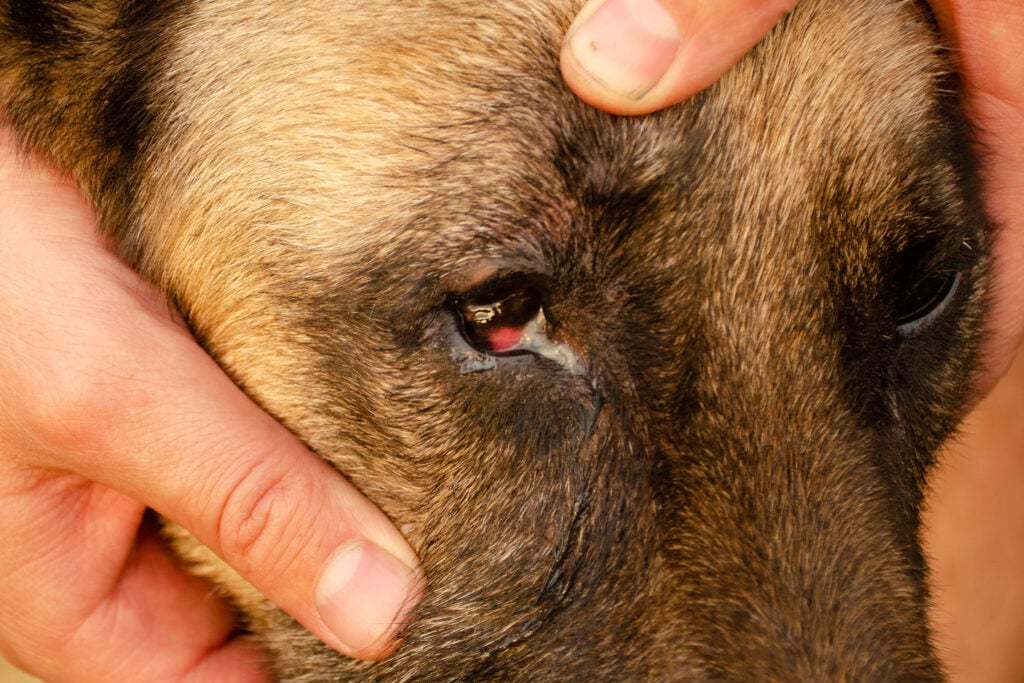
FAQs About Tear Staining On Dogs
Do you still have questions about your pup’s tear stains? I’ve answered the most common ones below, but if I’ve missed yours, drop it in the comments! We’d love to help.
Why Do Dogs Get Tear Stains?
Dogs get tear stains when tear moisture reacts with compounds in the tears, especially porphyrins, iron-rich molecules that cause red or brown discoloration. Tear stains are more common in breeds with flat faces, shallow eye sockets, or long facial hair.
Tear staining in dogs can be made worse by allergies, eye irritation, blocked tear ducts, or even diet. While they’re often harmless, chronic staining can sometimes point to an underlying health issue.
How Do I Know If My Dog’s Tear Stains Are A Problem?
If the stains are brown (not red), smell bad, or come with swelling, gooey discharge, or changes in behavior, it could mean a yeast infection or eye issue. In those cases, it’s best to see your vet.
Can Tear Stains Go Away On Their Own?
Not usually. Unless you address the root cause, like eye irritation, diet, or anatomy, the stains will stick around. Cleaning helps, but prevention is key.
Do Tear Stain Wipes Really Work?
Yes, but only if used consistently and paired with daily care like eye wiping, clean bowls, and possibly diet changes. Look for fragrance-free, pet-safe options approved for use around the eyes.
Can Food Really Affect Tear Stains?
For some dogs, absolutely. Foods with beef, fillers, dyes, or poor-quality ingredients can worsen inflammation and porphyrin buildup. Many owners see improvement after switching to a cleaner, limited-ingredient diet or a higher-quality option.
How Can I Reduce Porphyrin In My Dog?
Try giving distilled or filtered water instead of tap water, which may contain iron and other minerals. Avoid red meat-based diets like beef, which are higher in iron and can increase porphyrin production.
Are Tear Stains Harmful To My Dog?
The stains themselves aren’t dangerous, but the moisture they create can lead to skin irritation, yeast infections, or discomfort, especially in dogs with facial folds or long hair around the eyes.
Next Steps For A Healthier, Happier Dog
Keeping tear staining on dogs under control is just one part of keeping your dog healthy and happy. There’s always more to learn, from choosing the right food to building a better grooming routine.
And don’t forget the importance of annual wellness checkups, too. Your vet can catch minor problems before they become big ones.
Ready to dive deeper? Decode what your dog’s poop color might be telling you because, like the color of tear stains, your dog’s poop might be trying to tell you something’s up.
We Want To Hear From You! Has your household experienced tear staining in dogs? Perhaps you’ve found something that worked for your dog’s tear stains? Share your story in the comments – other pet parents are reading!
